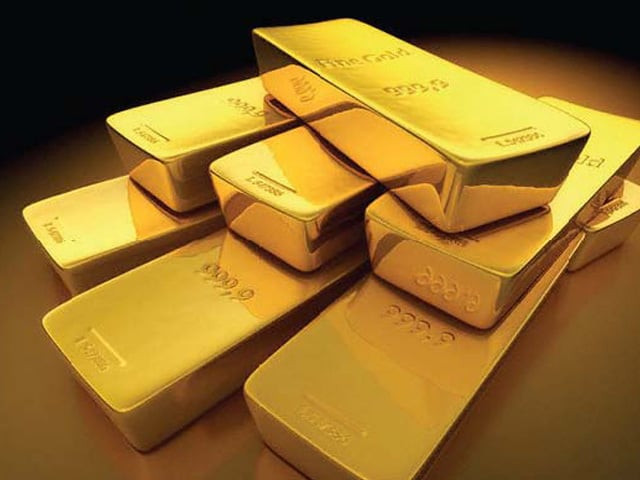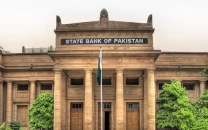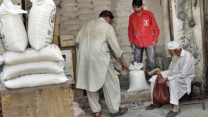Gold shines amid uncertainty
Geopolitical tensions, bank buying push gold to Rs287,900/tola

old prices in 2024 reached historic highs, driven by central bank purchases including by emerging markets and escalating geopolitical tensions. International rates peaked around $2,790 per ounce, while in Pakistan, prices soared to Rs287,900 per tola, reflecting gold’s role as a safe-haven asset.
Key factors included intensified conflicts in the Middle East and the lingering impact of Russia-Ukraine war, alongside concerns over US debt sustainability and fiscal risks. Central banks, particularly in China, India, and Turkey, boosted their reserves, while US inflation declines and interest rate cuts further enhanced gold’s appeal.
As Pakistan’s gold market delivered a 24% profit, outperforming other traditional investments like property and the US dollar, analysts predict further gains in 2025, with Goldman Sachs forecasting prices to hit $3,000 per ounce.
“Geopolitical tensions, reserve diversification, US economic vulnerabilities, and favourable macroeconomic conditions drove gold’s strong performance in 2024, solidifying its status as a safe-haven asset,” said Adnan Agar, Director of Interactive Commodities.
In 2024, gold prices have soared to multiple all-time highs, driven by significant central bank purchases, especially from emerging markets. This surge is attributed to concerns about financial sanctions and the debt sustainability of the US. Central banks have been buying gold to hedge against potential geopolitical shocks and fiscal risks in the US, according to Goldman Sachs Research.
The highest price of 24-karat gold was recorded on October 30, 2024, when international rates reached $2,784 per ounce, and the price in Pakistan soared to Rs287,900 per tola, according to the All Pakistan Saraf Gems and Jewellers Association (APSGJA).
Conversely, the lowest price was reached on February 14, 2024, with international rates at $2,010 per ounce and the local price at Rs210,800 per tola.
This significant price variation demonstrates that, despite the volatile nature of the gold market in 2024, influenced by currency fluctuations, geopolitical events, and changes in global demand, prices have surged dramatically, said Abdullah Abdul Razzaq, a member of the APSGJA, stating that the gold market in 2024 was significantly influenced by geopolitical tensions, particularly the ongoing Russia-Ukraine war and Israel’s conflicts with neighbouring countries.
Another major factor driving gold prices was the aggressive gold purchasing by central banks in China, India, and the United States, which added upward pressure on the market.
From March to late August 2024, gold prices consistently climbed, reaching a peak above $2800 in September. This rally was characterised by steady higher highs and higher lows, reflecting robust market confidence. However, after peaking, the market experienced a notable correction, with prices declining sharply and stabilizing around the $2620 range by December.
On a broader scale, the monthly trend highlighted a prolonged recovery starting from 2021, culminating in a sharp rally through mid-2024. By the third quarter, bullish momentum began to fade, leading to a bearish correction in November and December as prices retreated below $2650.
The gold’s performance in 2024 was shaped by multiple factors, starting with a rebound from its October 2023 low of $1,810, said Adnan Agar of Interactive Commodities. The Israel-Palestine conflict triggered a sharp rise in gold prices, peaking at $2,790 in October 2024. The involvement of Iran and Lebanon heightened fears of a broader Middle Eastern war, further boosting gold’s appeal as a safe-haven asset.
The ongoing Russia-Ukraine war also influenced prices, as Western sanctions on Russia prompted countries like China to diversify reserves by increasing gold holdings, he said. Over two years, nations including China, Turkey, India, and the UAE significantly boosted their gold reserves, contributing to upward price pressure.
In the US, rising debt levels – reaching $37 trillion and 125% of GDP –along with recurring debt ceiling crises and inflation fluctuations, added to gold’s attractiveness. The US inflation dropped to 2.4% in October 2024 before rising slightly to 2.7% by December. Concurrent Federal Reserve rate cuts lowered borrowing costs, reducing the opportunity cost of holding gold and increasing demand, Agar said.
Gold vs other assets
In 2024, gold emerged as a strong investment option in Pakistan, securing the third-largest gain among asset classes. Its value increased from Rs189,386 per 10 grams at the start of the year to Rs234,311 per 10 grams by December, delivering a 24% profit, as reported by Topline Securities.
Equities outperformed major asset classes in 2024, with the benchmark KSE-100 index achieving a remarkable 84% gain. According to AHL, the index added 52,676 points during the calendar year.
By the end of CY24, the KSE-All Market capitalisation grew by 61%, reaching Rs14.6 trillion, the highest ever CY closing, and peaking at Rs14.8 trillion on December 16. In dollar terms, market capitalisation closed at a six-year high of $52.3 billion, reflecting a 63% annual increase.
Conversely, the US dollar, a popular investment avenue in previous years, provided a negative return of 1% in 2024, declining from Rs282 to Rs278 in the interbank market.
In contrast to its strong returns of 24% and 28% in 2023 and 2022, respectively, this year’s decline was attributed to the PKR’s appreciation of 1.2%, supported by a current account surplus of $646 million in 11MCY24, higher remittances, and a rise in SBP’s reserves from $8.2 billion in December 2023 to over $12 billion by year-end.
Fixed-income investments gained traction in 2024 due to high interest rates. The average bank savings rate remained at 18%, while National Savings’ three-year Special Savings Certificates (SSC) delivered a 17% return. Local asset management companies’ money market funds provided an average return of 19%.
Similarly, the Naya Pakistan PKR Certificates under the Roshan Digital Account (RDA) yielded 22% in PKR terms. Government-issued PIBs and T-bills also performed well, offering returns of 27% and 21%, respectively.



















COMMENTS
Comments are moderated and generally will be posted if they are on-topic and not abusive.
For more information, please see our Comments FAQ